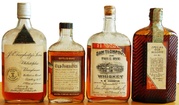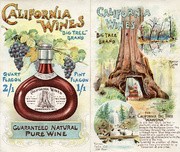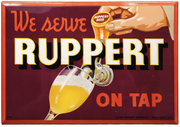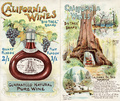
The historic alcohol labels that were on exhibit a few years ago at the California Historical Society in San Francisco were all printed during the Great Depression of the 1930s, when millions of Americans drowned their economic sorrows in newly legal beer, wine, and assorted spirits. These bottles of previously demon alcohol were adorned with illustrations of pretty girls, dramatic sunsets over the Golden Gate Bridge, boxers in the ring, mission bells unrung, and endless clusters of fat, ripe grapes hanging on the vine.
“Most of the wine made in California in the 1930s was downright awful.”
The graphics, though, were not intended to ease the sting of circumstances. Their job was to disguise the poor quality of the liquid within the bottle, especially when it came to wine, as author Frances Dinkelspiel explains in her foreword to one of two books published in conjunction with the exhibition. “Most of the wine made in California in the 1930s,” Dinkelspiel writes, “was downright awful.” This “lackluster plonk,” she continues, “was a legacy of Prohibition, which had decimated the once robust industry.”
During Prohibition, the only way for vineyards to survive was to make sacramental wine for the tightly regulated, and very small, market of priests and rabbis, or to grow grapes that could be sold whole and crushed into wine by the heads of households—by law, 200 gallons per year of homemade hooch were permitted. Grape growers responded by ripping out the thin-skinned grape varieties that had been so popular for dry table wine and replacing them with sweeter, thick-skinned grapes that could withstand the rigors of train travel. Thus, by the time Prohibition was repealed on December 5, 1933, the wine industry was crushing grapes that had hardly been planted for their eventual complexity as wine. The result was untold gallons of sweet “port” and “sherry” fortified with brandy until it reached an alcohol content of 20 percent. Fancy labels gave this swill a veneer of respectability, while the high alcohol content no doubt gave drinkers something other than the taste in their mouths to think about.

















 The Forgotten Kingpins Who Conspired to Save California Wine
The Forgotten Kingpins Who Conspired to Save California Wine
 Drunk History: The Rise, Fall, and Revival of All-American Whiskey
Drunk History: The Rise, Fall, and Revival of All-American Whiskey The Forgotten Kingpins Who Conspired to Save California Wine
The Forgotten Kingpins Who Conspired to Save California Wine Beer Money and Babe Ruth: Why the Yankees Triumphed During Prohibition
Beer Money and Babe Ruth: Why the Yankees Triumphed During Prohibition AdvertisingFrom colorful Victorian trade cards of the 1870s to the Super Bowl commerci…
AdvertisingFrom colorful Victorian trade cards of the 1870s to the Super Bowl commerci… Mari Tepper: Laying it on the Line
Mari Tepper: Laying it on the Line Nice Ice: Valerie Hammond on the Genteel Charm of Vintage Canadian Costume Jewelry
Nice Ice: Valerie Hammond on the Genteel Charm of Vintage Canadian Costume Jewelry How Jim Heimann Got Crazy for California Architecture
How Jim Heimann Got Crazy for California Architecture Modernist Man: Jock Peters May Be the Most Influential Architect You've Never Heard Of
Modernist Man: Jock Peters May Be the Most Influential Architect You've Never Heard Of Meet Cute: Were Kokeshi Dolls the Models for Hello Kitty, Pokemon, and Be@rbrick?
Meet Cute: Were Kokeshi Dolls the Models for Hello Kitty, Pokemon, and Be@rbrick? When the King of Comedy Posters Set His Surreal Sights on the World of Rock 'n' Roll
When the King of Comedy Posters Set His Surreal Sights on the World of Rock 'n' Roll How One Artist Makes New Art From Old Coloring Books and Found Photos
How One Artist Makes New Art From Old Coloring Books and Found Photos Say Cheese! How Bad Photography Has Changed Our Definition of Good Pictures
Say Cheese! How Bad Photography Has Changed Our Definition of Good Pictures Middle Earthenware: One Family's Quest to Reclaim Its Place in British Pottery History
Middle Earthenware: One Family's Quest to Reclaim Its Place in British Pottery History Fancy Fowl: How an Evil Sea Captain and a Beloved Queen Made the World Crave KFC
Fancy Fowl: How an Evil Sea Captain and a Beloved Queen Made the World Crave KFC
Nice article and an interesting bit of American history Ben. I’m looking to get me some of that “Pep-Tol Port Wine Tonic” Dosage guidelines and everything…Ha!
Up too late randomly surfing and stumbled upon this nice gem of an article. Well written. I enjoyed it. Regards,
Vintage beer tray collector
Perhaps not unrelated: in grade school we had the jokes. “I put a bar in the back of my car and drove myself to drink” and “Nobody was driving officer. We were all in the back seat drinking.” There must be a collection of them out there somewhere.